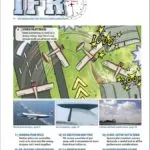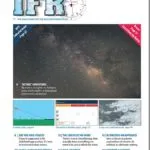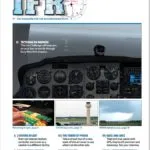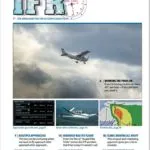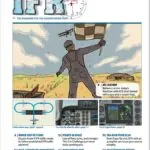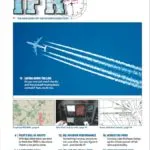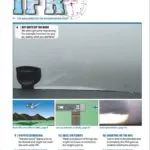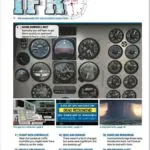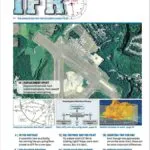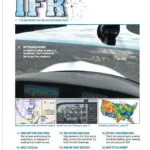Download the Full January 2018 Issue PDF
Always pay attention. Good advice, that, applying equally to all human endeavors. But it especially applies to those of us who pilot aircraft. Ive often stressed the traps and dangers of becoming too reliant on automation. Dont let it become a crutch, Ive preached. Consequently, youd think, as I did, that Id be particularly wary of that malady. Yes, youd think…
Download the Full December 2017 Issue PDF
The milestone of sorts that I discovered is that this issue marks my fifth anniversary at the helm of IFR. Now, in many views, thats simply not noteworthy. Other editors in the Belvoir Aviation family, like Jeb Burnside at Aviation Safety, have been at this for, well, a very long time indeed.
Download the Full November 2017 Issue PDF
Most pilots and aviation journalists think BasicMed is a win. For many it is. But, if you dig beneath the covers you might conclude its not a win for you. Behind closed doors Ive been equivocal about BasicMed, but weve been generally favorable in print. I personally like the ever-cautious wait-and-see approach. Waiting and seeing, combined with a letter from James Shepard (see Readback), lead me to conclude that perhaps BasicMed isnt the big win most of us hoped and thought it would be.
Download The Full October 2017 Issue PDF
His destination airport had a runway closed. The advertised approach that he was supposed to be flying was an approach to the closed runway, with a circle to the active runway. Thats how Id been clearing him. The way things were going, I was taking no chances. I verified on-frequency that he was aware of the runway closure and that he was supposed to circle to the other runway. It seemed to get across, although I cant say for certain if he knew about it before I spoke up.
Download The Full September 2017 Issue PDF
Assuming you own an airplane or fly the same one all the time, consider joining the type club supporting that aircraft. Okay, thats your takeaway. Let me explain why I recommend that. Ive owned three airplanes. My first was a mighty Cessna 150 and I was too young and too ignorant for aircraft ownership, so that one doesnt count. Next was a Mooney, a 1968 M20F Executive. Older and wiser then, I had previously joined the Mooney Aircraft Pilots Association (MAPA).
Download The Full July 2017 Issue PDF
The FAA has long had its WINGS program focused on increasing the skill levels of all pilots. In 2008, it received a major face lift, became web based (www.faasafety.gov), and offered many different opportunities for pilots to increase proficiency without the ab- solutes of a pass/fail review or check ride. There are three levels of WINGS: the Basic, Advanced, and Master phases. Each level has multiple phases. Unlike the previous program, multiple phases can be earned each year. To complete a phase, pilots must get three flight and three ground credits which can be chosen from a wide range of activities.
Download the Full June 2017 Issue PDF
Many mainstream aviation publications include a recitation of facts about selected accidents. The idea, Im sure, is a there-but-for-the-grace-of-God-go-I kind of warning. Clearly theres value in that information, but when I read those sections Im often left with a so-what or too-bad-for-them reaction because discovering the applicability of those mishaps is left to the reader. IFR has never published many articles about accidents. However, weve recently begun to occasionally include that article genre in the lineup of the mag.
Download the Full May 2017 Issue PDF
Anything that can go wrong, will, and at the worst possible moment-so states Finagles corollary to Murphys Law. This notion is drilled into pilots from the beginning, so that it becomes second nature to have a plan to handle all sorts of potential failures that could be experienced in flight. Engine failure: check. Instrument and system malfunction: got it covered. Communication failure: no problem. GPS failure... Uhhh, what? Hang on a minute.
Download the Full April 2017 Issue PDF
Aviation widely relies on the transfer of institutional knowledge. The flight instructor teaching you to fly didnt acquire all his/her skills alone. Someone taught them the basics, who in turn was taught by another individual, and so on. Lessons from past experience (a.k.a. mistakes) enlighten future generations. ATC is no different. Regardless of background, when a controller walks in the door of an ATC facility, they need to learn how to work that particular facilitys airspace. Achieving certification depends on the experience and guidance of the other controllers and staffers.
Download the Full March 2017 Issue PDF
The FAA is focusing on increasing the use of PBN procedures, particularly RNAV STARs. Increased use of PBN procedures will reduce ATC complexity and simplify traffic sequencing. PBN begins to really shine as new, more efficient traffic management and avionics capabilities enter the NAS. Pilots will find ATC more predictable and discover more opportunities to fly efficiently. At about 3300 smaller airports, safer PBN approaches with LPV and LNAV/VNAV minimums will be commissioned to every qualified runway. Most, but not all, airports will have an IAP to at least one runway end.
Download the Full February 2017 Issue PDF
A 20-knot headwind or tailwind for a gliding 747 makes for a rounding error, but for an engine-out single it can mean the difference between an on-airport landing and an off-airport tragedy. Glider pilots have charts and techniques for speed and loading to maximize their performance, including adjustments for wind. They call it Speed to Fly; for X headwind increase the indicated glide speed to Y for a new rate of descent of Z.

